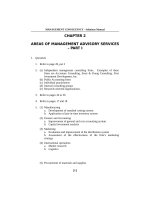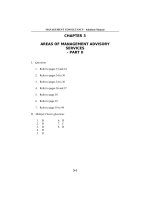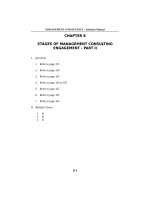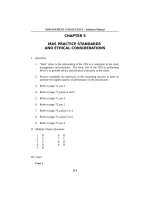Management consultancy by cabrera chapter 23 answer
Bạn đang xem bản rút gọn của tài liệu. Xem và tải ngay bản đầy đủ của tài liệu tại đây (73.8 KB, 2 trang )
MANAGEMENT CONSULTANCY - Solutions Manual
CHAPTER 23
PFS: PROJECT BACKGROUND
AND ECONOMIC ASPECT
I.
Questions
1. Refer to page 459
2. Refer to page 461
3. Refer to pages 465 to 471
4. Refer to pages 472 to 473
5. Refer to page 472
6. Refer to page 476
7. Refer to page 477
II. Case Problem
Step 1: Find the demand unit function.
The data given in table form are plotted on a cc-place, and a freehand
straight line is fitted to the points, as shown on page 17-2. From the
chart we may read points (5.50, 4500) and (10, 0). Let p represent the
price and q units of the mechanical toy. Substituting in formula (2) of
Arithmetic (Linear) trend method, we have
=
and
q - 4500
0 - 4500
4.50(q
4500)
=
-4500(pp - 5.50
10 - 5.50 5.50),
q = Q(p) = -1000p + 10,000.
Note that Q is the unit demand function where price is the independent
and quantity the dependent variable.
23-1
Chapter 23
PFS: Project Background and Economic Aspect
Q (p)
10,000
9,000
8,000
7,000
6,000
(5.50, 4,500)
5,000
4,000
3,000
2,000
Q(p) = -1,000p +
10,000
1,000
(10, 0)
Step 2: Find the total cost function.
1
2
3
4
5
6
7
9 10
0
8
p
Let C be such a function. Since fixed costs are expected to be P5000
- PESOS)
and variable P2.00 per toy,(PRICE
the cost
function by formula (1) of
Arithmetic (Linear) trend method is
C(q) = 2q + 5000.
On the basis of functions Q and C we can derive the sales revenue and
profit functions.
23-2









